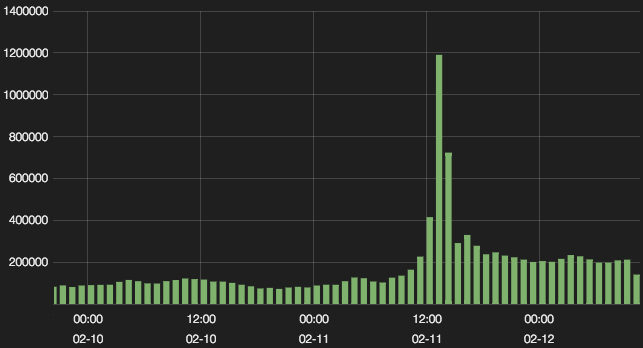You have /5 articles left.
Sign up for a free account or log in.

Not a gravitational wave, but a surge in web traffic after 'Physical Review Letters' published the LIGO paper.
American Physical Society
In order to decide where to publish one of the most significant discoveries in the history of physics, the scientists put it to a vote.
Last September, before ripples in space-time set off detectors at the two Laser Interferometer Gravitational-Wave Observatory sites in Louisiana and Washington State, members of the LIGO Scientific Collaboration were asked to decide how they would announce the paradigm-shattering discovery of gravitational waves, first predicted by Albert Einstein’s general theory of relativity in 1916.
The group’s council members -- representatives from the 83 institutions participating in the effort -- began casting their ballots online on Sept. 9, 2015. Peter K. Fritschel, chief detector scientist at LIGO, said a “clear favorite” soon emerged: Physical Review Letters, the flagship journal of the American Physical Society.
The vote quickly came in handy. Five days later, the first observable gravitational waves, caused by the merger of two black holes 1.3 billion years ago, reached Earth.
The poll is one example of the painstakingly detailed procedures in place for a scientific undertaking more than four decades and $1.1 billion in the making. Each step of the process, from discovery to dissemination, is meticulously planned out. There’s a committee in place to make a detection claim, a second to analyze that claim, a third to write the paper -- and numerous others. There is also a designated spokesperson, who contacted Physical Review Letters in December to discuss how long it would take to review and publish the groundbreaking paper.
There, LIGO discovered an organization with thorough procedures of its own.
“I was excited to learn that the paper was coming to our journal,” editor Robert Garisto said in an interview. “I was also cognizant of the need for complete confidentiality.”
Garisto declined to speculate about why LIGO chose the journal, but it is not difficult to see why. The journal is one of the most prestigious in the field and has a long history of publishing research that went on to win Nobel Prizes. Fritschel, who is based at the Massachusetts Institute of Technology, also cited its status as one of the “premier journals for physics results” as one of the reasons Physical Review Letters stood out as a “pretty clear winner” among LIGO members.
Garisto told one other person: Abhishek Agarwal, the associate editor who normally handles papers on the topic. The two worked in secret for about a month before they began involving others on a “need-to-know basis.” Concerned that news about the discovery and the journal’s involvement would leak, Garisto instructed the others to refer to it as “Big Paper.”
Other than a last-second cover redesign, the publication process proceeded without drama, Fritschel said. The manuscript arrived at the journal Jan. 21, three weeks before the LIGO researchers were scheduled to announce their findings at a press conference in Washington. The date had been “penciled in” about a month in advance, he said. The paper returned from peer review on Jan. 27, and the researchers resubmitted it on Jan. 31.
Garisto declined to share any comments about the confidential peer-review process, but added, “I don’t think it would be shocking to know that the referees thought the paper was really good.”
Normally, the journal publishes a paper as soon as it has been proofed and the supplemental materials -- graphics, a viewpoint and so on -- have been produced, Garisto said. With the LIGO paper, the journal had to coordinate with the researchers to make sure publication coincided with the announcement at the press conference.
“We actually had someone standing ready to push the button at a particular time,” Garisto said. “When they did push the button, the servers all went down.”
Mark Doyle, chief information officer for the American Physical Society, said the association normally runs four web servers hosted by Amazon Web Services, a popular cloud hosting service, to handle the traffic to its journals. In preparation of a spike in traffic, the association added two more servers the night before the article went live.
“When the flood of requests hit our website immediately after the publication of the article at 10:30 a.m., we were seeing approximately 10,000 hits per minute,” Doyle said in an email. “After increasing the number of requests each web server could handle, we were still experiencing significant loading of the website, so we added four more high-capacity servers by 11:45 a.m. Despite this very significant increase in server capacity, we were still under heavy load, so by 12:30 we had added 10 more high-capacity servers, more than quintupling our usual capacity. This finally was able to cope with the traffic we [were] seeing.”
Added Garisto, “Obviously it’s not a good thing when your server goes down, but on the other hand, every LIGO author I talked to was ecstatic that they managed to bring our server down.”
Physical Review Letters is a hybrid open-access journal. Authors can make the decision to publish open access themselves. If they, like the LIGO researchers, want to make their work available under a Creative Commons license, they can pay a $2,900 article processing charge. The journal also makes every paper it publishes a viewpoint on available to read for free, which totals about 75 additional papers a year, Garisto said.
Open access is a less-debated topic in STEM compared to fields with less funding for research, however. Fritschel, for example, said he didn’t consider the availability of open-access publishing when he voted.
Garisto said only a small fraction of authors choose the open-access route when publishing in Physical Review Letters, but the list does include some prominent examples, such as findings from the Large Hadron Collider. The journal publishes about 2,500 papers a year.
“I’m really glad the paper was open access,” Garisto said. “This is the kind of result that will be read far outside the physics community.”

![First text message: "Yes?" Second message: "This is embarrassing to say, but law school isn't fair for us men, the women are always outperforming us at [sic]. It's obvious women are taking over the legal profession nowadays." Third text: "Who is this?"](/sites/default/files/styles/image_192_x_128/public/2024-09/Text_messages_law_2.jpg?itok=0QWP419B)






